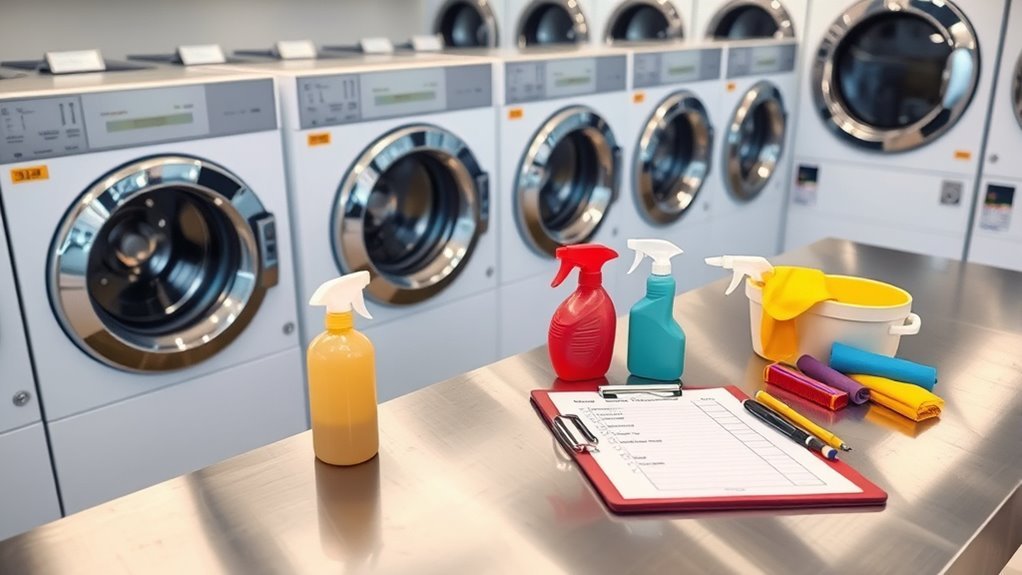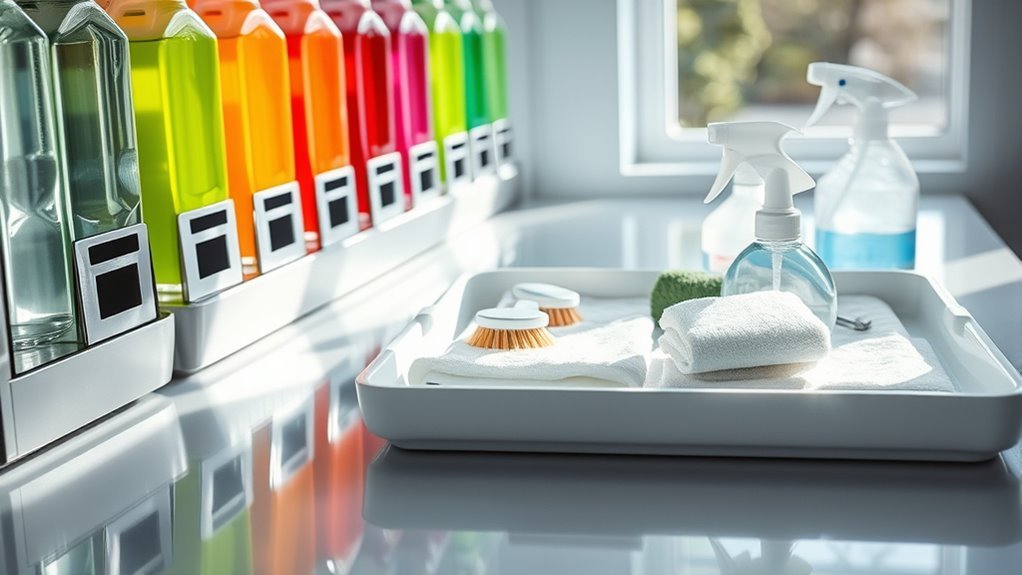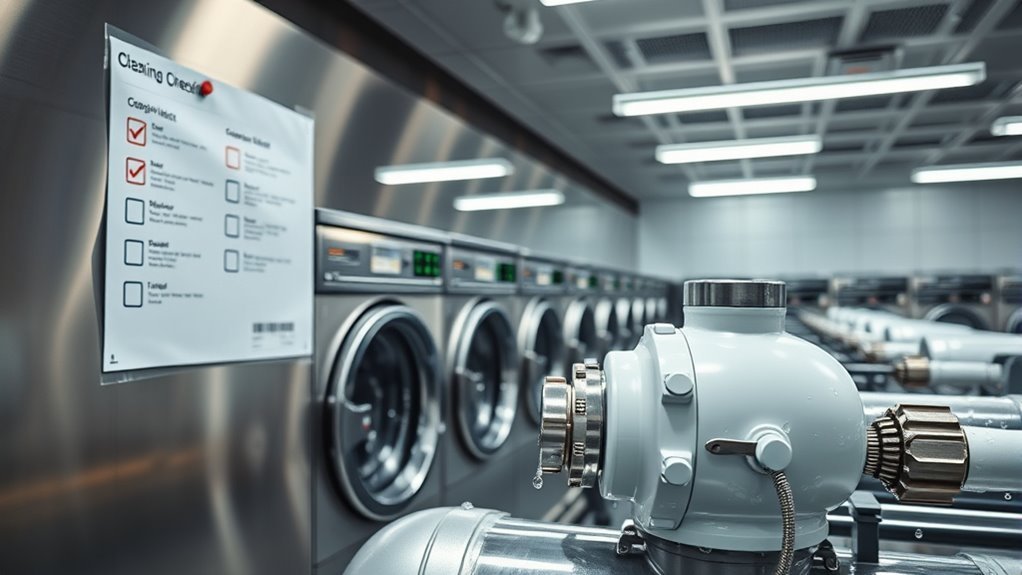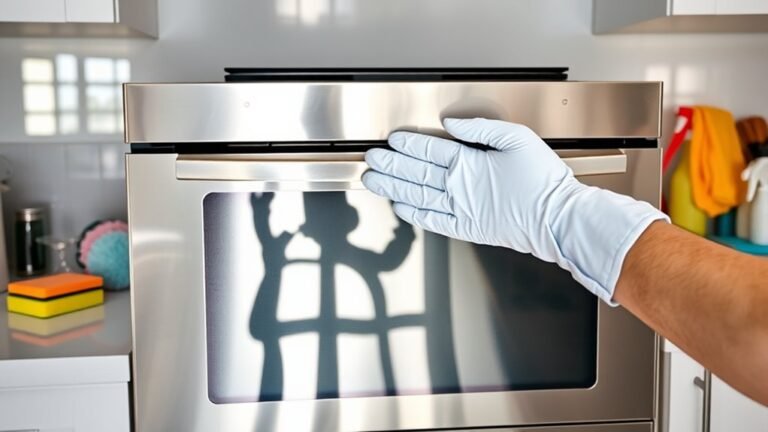Cleaning Checklist for Washer Businesses
You’ll want to start each day by wiping surfaces, clearing lint traps, and inspecting door seals to keep washers running smoothly. Weekly, disinfect handles, clean filters, and check hoses for leaks. Monthly, inspect belts, electrical parts, and drainage systems carefully. Don’t forget to regularly clean detergent dispensers and sanitize exteriors with the right products. Training your staff on these routines guarantees consistent hygiene and efficiency. Stick with these steps, and you’ll uncover even more ways to optimize your washer business.
Daily Cleaning Tasks for Washers

Although it might seem routine, performing daily cleaning tasks for washers is essential to maintain their efficiency and hygiene. You need to wipe down the exterior surfaces to remove dust and detergent residue, preventing buildup that can impair daily efficiency. Clear the detergent dispensers and lint traps to avoid blockages that reduce machine performance. Inspect door seals carefully, as trapped moisture and debris can lead to mold growth, compromising cleanliness and machine longevity. Make certain to run a quick rinse cycle without clothes to flush out any lingering detergent or dirt. These consistent actions don’t just keep your washers looking good—they guarantee they operate smoothly, reducing downtime and costly repairs. Staying on top of these tasks grants you freedom from unexpected breakdowns and keeps your business running reliably.
Weekly Deep Cleaning Procedures
Each week, you’ll need to thoroughly inspect your washers for any signs of wear or damage to keep them running smoothly. Make sure to disinfect all high-touch surfaces to prevent the spread of germs and maintain hygiene. Don’t forget to clean the drains and filters, as buildup here can cause blockages and reduce efficiency.
Equipment Inspection Steps
When performing your weekly deep cleaning, you’ll want to start by thoroughly inspecting all washer components to identify any signs of wear, buildup, or damage. This step is essential to maintaining equipment performance and ensuring safety protocols are upheld. Focus on these key inspection points:
- Check hoses and connections for leaks or cracks that could cause malfunctions.
- Examine drum seals and gaskets for tears or residue buildup that may affect efficiency.
- Inspect electrical components and wiring for wear or exposed areas that risk safety.
- Assess filters and dispensers, removing any clogs or deposits that hinder proper operation.
Disinfecting High-Touch Surfaces
Since high-touch surfaces can harbor germs and bacteria, you need to disinfect them thoroughly during your weekly deep cleaning. Focus on door handles, control panels, payment systems, and folding tables—areas customers and staff touch frequently. Follow strict disinfecting protocols to guarantee you’re using EPA-approved cleaners suitable for these surfaces. Apply the disinfectant evenly and allow it to sit for the recommended contact time to maximize effectiveness. Don’t rush surface sanitization; skipping steps compromises hygiene and customer safety. Using microfiber cloths helps prevent cross-contamination, so change them often during cleaning. Document your procedures to maintain consistency and accountability. By mastering these disinfecting protocols, you protect your customers and create a cleaner, safer environment without sacrificing your operational freedom.
Drain and Filter Cleaning
Although regular surface cleaning keeps your washer business looking presentable, neglecting drain and filter maintenance can lead to clogs, odors, and machine inefficiencies. To keep everything running smoothly, prioritize weekly drain and filter cleaning. Here’s how to stay ahead of drain blockage and guarantee timely filter replacement:
- Inspect the drain for any debris buildup; remove blockages promptly to prevent backups.
- Clean the drain trap thoroughly using a brush and warm water.
- Check filters for dirt accumulation; replace filters according to manufacturer guidelines or sooner if heavily soiled.
- Run a maintenance cycle with a washer cleaner to flush out residual grime.
Monthly Maintenance and Inspection
To keep your washers running efficiently and prevent costly breakdowns, you need to perform monthly maintenance and inspections without fail. Establish a strict inspection schedule as part of your preventive maintenance plan to catch issues early. Focus on critical components like hoses, belts, and electrical connections, ensuring they’re intact and functioning well. Here’s a practical checklist:
| Task | What to Check | Action Required |
|---|---|---|
| Inspect hoses | Cracks, leaks | Replace if damaged |
| Check belts | Wear, tension | Adjust or replace |
| Test electrical parts | Connections, frays | Repair or secure |
| Clean exterior surfaces | Dirt, grime | Wipe down thoroughly |
| Review machine operation | Noise, vibrations | Investigate abnormalities |
Stick to this routine, and your washers will serve you longer with fewer interruptions.
Cleaning Detergent Dispensers and Trays

After handling monthly maintenance and inspections, giving attention to detergent dispensers and trays is equally important. These components often collect residue from various detergent types, which can impair function and lead to buildup. To keep your washers performing at their best, follow these steps:
Don’t overlook detergent dispensers and trays during maintenance to prevent residue buildup and ensure washer efficiency.
- Remove trays carefully, noting dispenser materials to avoid damage.
- Soak trays in warm water mixed with a mild cleaning agent suitable for all detergent types used.
- Scrub dispensers and trays with a soft brush, focusing on corners and crevices where residue accumulates.
- Rinse thoroughly and dry before reassembling to prevent mold and detergent buildup.
Addressing Washer Drum and Door Seals
Two critical areas that often get overlooked in washer maintenance are the drum and door seals. Proper drum maintenance guarantees your machines run efficiently and prevents mold buildup that can cause odors or damage. Regularly wipe down the drum, checking for debris and residue that can accumulate over time. Equally important is seal inspection; the door seals trap moisture and dirt, making them prone to mildew and tears. You should carefully examine the seals for cracks or mold, cleaning them with a mild detergent and a soft cloth to maintain their integrity. Neglecting these areas can lead to costly repairs and downtime. Staying on top of drum maintenance and seal inspection gives you control, extending your washers’ lifespan and keeping your business running smoothly.
Managing Drainage and Filter Systems

You need to keep your drainage system clear to prevent backups and guarantee smooth water flow. Regularly check and clean filters to avoid clogs that can damage your washers or reduce their efficiency. Following a strict schedule for these tasks will help maintain peak performance and extend your equipment’s lifespan.
Regular Drain Maintenance
A well-maintained drainage and filter system is essential for keeping your washers running smoothly and preventing costly backups. To avoid drain blockages, you need to be proactive with regular maintenance. Routine inspections help you spot early signs of buildup or slow drainage, so you can address issues before they escalate.
Follow these steps to keep drains clear:
- Schedule weekly visual checks for debris or standing water in drain areas.
- Use a drain snake or hydro-jetting quarterly to clear potential blockages.
- Inspect drain traps and pipes for leaks or corrosion during monthly maintenance.
- Keep a log of all inspections and maintenance activities to track patterns and plan ahead.
Filter Cleaning Procedures
Although regular drain maintenance is essential, keeping filters clean is equally important to guarantee your washers operate efficiently. You should schedule routine inspections to remove debris and buildup from filters, ensuring peak filter efficiency. Neglecting this step can lead to clogs, reduced water flow, and increased wear on your machines. Use manufacturer-recommended tools for filter cleaning to avoid damage. Keep a log of filter replacement intervals, as worn or damaged filters compromise performance and can cause costly downtime. When performing filter replacement, always choose high-quality parts that match your washers’ specifications. By maintaining a consistent filter cleaning routine, you’ll extend equipment life and maintain peak operational freedom, minimizing interruptions and maximizing your business’s productivity. Prioritize filter care to keep your washers running smoothly and reliably.
Sanitizing Washer Exterior Surfaces
Since washer exteriors are high-touch areas, regularly sanitizing them is crucial to prevent the spread of germs and maintain a professional appearance. You need to focus on thorough exterior surface cleaning to protect both your customers and your equipment’s longevity. Proper washer finish maintenance guarantees the surfaces stay in top condition without wear or damage. Follow these steps to sanitize effectively:
- Use a disinfectant compatible with the washer finish to avoid corrosion or dulling.
- Apply with a microfiber cloth to reach all control panels, door handles, and edges.
- Allow the disinfectant to sit for the recommended dwell time to kill pathogens.
- Wipe away any residue to prevent buildup and maintain a clean, polished look.
Consistent sanitizing promotes hygiene and helps your business stand out.
Best Practices for Cleaning Staff Training
When training your cleaning staff, you’ll want to focus on clear, consistent protocols that guarantee every washer is cleaned to the same high standard. Start by developing thorough training techniques that combine hands-on practice with detailed checklists. Engage your staff by encouraging questions and providing real-time feedback, boosting staff engagement and ownership of their duties. Use demonstrations to show proper sanitizing methods and emphasize safety precautions. Regularly update training materials to reflect any new cleaning agents or equipment. Track progress with assessments to confirm everyone meets your standards. By fostering a culture of responsibility and continuous improvement, you empower your team to maintain cleanliness efficiently, giving you the freedom to focus on growing your business without worrying about inconsistent cleaning results.
Frequently Asked Questions
How Often Should I Replace Washer Hoses to Prevent Leaks?
You should replace your washer hoses every 3 to 5 years to guarantee effective hose maintenance and leak prevention. Even if they look fine, hoses can weaken over time, increasing the risk of sudden leaks or bursts. Regularly inspecting for cracks or bulges helps, but scheduled replacements give you peace of mind. Staying proactive lets you avoid costly water damage, keeping your laundry running smoothly and your freedom from unexpected repairs intact.
What Are the Signs of Mold Growth Inside Washers?
Isn’t it just delightful when your washer surprises you with an unexpected science experiment? If you notice a musty smell, dark spots around the drum, or residue on clothes, it’s a clear sign of mold growth. To keep things fresh, prioritize mold prevention by regularly cleaning seals and running maintenance cycles. Remember, consistent washer maintenance not only protects your clothes but also preserves your freedom from stubborn, stubborn mold issues.
Can Vinegar Damage Washer Components if Used Regularly?
You might wonder about vinegar effects on your washer if you use it regularly. While vinegar is great for removing odors and mineral buildup, using it too often can harm rubber seals and hoses, leading to leaks or damage. For proper washer maintenance, it’s best to use vinegar occasionally, not after every wash. This balance helps keep your machine clean without compromising its components, giving you lasting freedom from costly repairs.
How Do I Handle Odor Issues in Front-Loading Washers?
Odors in your front-loading washer can sneak up like unwelcome guests. To tackle this, prioritize front loader maintenance by regularly wiping the door seal and drum. Leave the door ajar after cycles to let moisture escape, preventing mildew buildup. Use a specialized washer cleaner monthly for odor elimination, avoiding harsh chemicals that might harm components. Staying consistent gives you the freedom to enjoy fresh laundry without the worry of persistent smells.
Are There Eco-Friendly Cleaning Products Safe for Commercial Washers?
Yes, you can definitely find eco friendly options with safe ingredients for commercial washers. Look for cleaners labeled biodegradable and free from harsh chemicals like phosphates or chlorine. These products protect your machines, the environment, and guarantee a fresh, residue-free clean. By choosing such options, you maintain your washer’s performance without compromising on safety or sustainability, giving you the freedom to run your business responsibly and efficiently.






